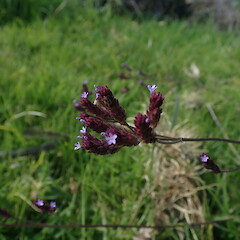Verbena brasiliensis
Common name
Brazilian vervain
Synonyms
Verbena quadrangularis Vell., Verbena hansenii Greene, Verbena litoralis forma angustifolia Chod., Verbena approximata Briq., Verbena brasiliensis var. subglabrata Moldenke, Verbena chacensis Moldenke, Verbena litoralis Kunth var. congesta Moldenke
Family
Verbenaceae
Flora category
Vascular – Exotic
Structural class
Herbs - Dicotyledons other than Composites
Conservation status
Not applicable
Distribution
North Island. South Island. In New Zealand V. brasiliensis is a rare weed found in the Far North in Hokianga and the Bay of Islands, as well as Westport on the West Coast of the South Island.
Introduced in Northern America, Mexico (Michoacan, Nuevo León, Sinaloa), Europe, Africa (South Africa), Madagascar, Australia.
Detailed description
Plants annual or short-lived perennial, taprooted or with ligneous fibrous roots. Stems erect, 70–150(–250) cm, sparsely to moderately hispid. Leaves persistent, lanceolate to rhombic-lanceolate 8 or lanceolate-elliptic, cuneate-attenuate at base, midstem blades (2–)5–8 cm x 10–25 mm, veins impressed adaxially, adaxially strigose-hirsute, abaxially hirsute mostly along the veins, margins serrate; petioles absent. Spikes in 3s, forming compound cymes, the central sessile to subsessile on peduncles 0–5(–10) mm, inflorescence aspect corymbiform, comprising relatively compact and distinct clusters and subclusters, central and laterals dense and thick in fruit, (5–)10–30(–50) mm x 3– 5 mm; floral bracts narrowly lanceolate, 2.5–4 mm, about equal or longer than the calyces. Calyces (2.5–)3–3.5 mm, loosely strigose to hirsute-strigose, eglandular, lobes connivent. Corollas usually purple to blue or blue-violet, tubes 3–4 mm, limbs (2–)2.5–3.5 mm in diam. Nutlets 1–1.4 mm, commissural faces extending to very tip of nutlets, densely papillate. 2n = 28.
Similar taxa
Distinguished from other members of the genus Verbena by the petiolate leaves, non-creeping habit, and stout flower spikelets.
Flower colours
Red/Pink, Violet/Purple
Year naturalised
1949
Origin
Tropical America - Eastern Brazil.
Attribution
Fact sheet prepared by Marley Ford (5 March 2022). Brief description and Distribution sections are copied from Nesom (2010).
References and further reading
Ford M. (2022). Verbena incompta P.W.Michael: an overlooked name for an old weed in New Zealand. New Zealand Journal of Botany: 1–11. (Published online: 23 May 2022)
Nesom G.L. (2010). Taxonomic notes on Verbena bonariensis (Verbenaceae) and related species in the USA. Phytoneuron 12: 1–16.









